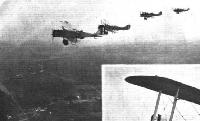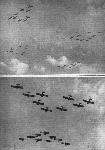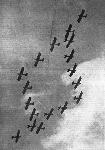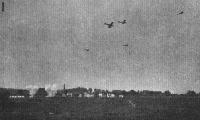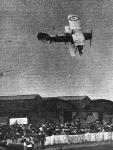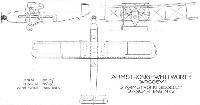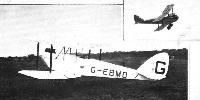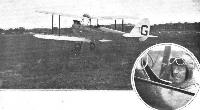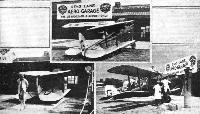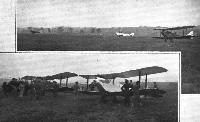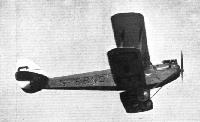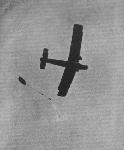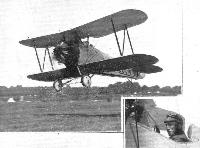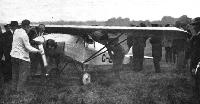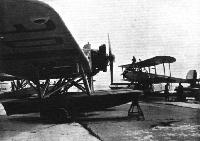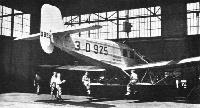Фотографии
-
THE THIRD R.A.F. "PAGEANT," 1922 : A much-appreciated event on this year's programme was "bombing a tank" by four Sopwith Snipes, in which the "bombs" were clearly visible during their fall and subsequent hit.
Самолёты на фотографии: Sopwith Snipe / 7F.1 - Великобритания - 1918
-
The Sopwith "Snipe," 200 h.p. B.R.2 (No. 6), flown by Lieut. Longton in the Aerial Derby
The Sopwith "Snipe" (B.R.2 Rotary) Of the types of aircraft in use at the end of the war, quite a number have been retained. In many cases this has necessitated "reconditioning" the machines which had been kept in stores for several years, and among the types that have been reconditioned, as well as built de novo, is the Sopwith "Snipe," a single-seater fighter with rotary engine. The introduction of more powerful radial air-cooled engines has rendered the rotary obsolete. Thus the "Snipe" is now about to disappear altogether. The only squadrons still equipped with it are: No. 1 (Fighter) Squadron, Kenley, and No. 43 (Fighter) Squadron, Henlow.Самолёты на фотографии: Sopwith Snipe / 7F.1 - Великобритания - 1918
-
"A DRESS REHEARSAL": Some D.H.9a's of No.39 Bombing Squadron carrying out evolutions over Hendon. Note the formation of Fairey "Fawns" in the left-hand corner of the top picture.
Самолёты на фотографии: De Havilland D.H.9A - Великобритания - 1918Fairey Pintail / Fawn - Великобритания - 1920
-
THE FOURTH R.A.F. "PAGEANT," 1923: A distinct advance was seen in this year's formation flying, both in quantity and quality. Ten D.H.9a's from No. 39 Squadron (Spittlegate) execute some close evolutions.
Самолёты на фотографии: De Havilland D.H.9A - Великобритания - 1918
-
THE FIFTH R.A.F. "PAGEANT," 1924: The most thrilling event of all those presented up to this fifth year was certainly the demonstration of air drill given by two Squadrons (Nos. 39 and 207) of D.H.9a's, 18 machines in all, a slight impression of which is shown.
Самолёты на фотографии: De Havilland D.H.9A - Великобритания - 1918
-
MORE GROUP EVOLUTIONS: These were carried out by two Wings of two day-bombing squadrons (Nos .11 and 12, Fairey Fawns, and Nos. 39 and 207, D.H. 9As). In the top view the four squadrons flying together, and below, flying towards one another.
Самолёты на фотографии: De Havilland D.H.9A - Великобритания - 1918Fairey Pintail / Fawn - Великобритания - 1920
-
A FINE FORMATION: Were each of the two day-bombing squadrons, in "Squadron" formation, pass over each other and produce a wonderful pattern.
Самолёты на фотографии: De Havilland D.H.9A - Великобритания - 1918Fairey Pintail / Fawn - Великобритания - 1920
-
AT THE R.A.F. DISPLAY: During the afternoon the four Fairey IIID biplanes, piloted by Wing-Corn. Pulford and his companions, recently back from their Cairo-Cape-Cairo flight flew over the aerodrome and saluted the Royal Enclosure.
Самолёты на фотографии: Fairey Fairey III - Великобритания - 1917
-
U.S. AIR MAIL SERVICES. C.A.M. NO.4: One of six Douglas M.2 mail 'planes employed by the Western Air Express, Inc., on the Salt Lake City to Los Angeles route.
Самолёты на фотографии: Douglas M-1 - M-4 - США - 1925
-
AN EXTRA TURN AT THE KING'S CUP RACE: An S.E.5 (Savage Sky-Writing) and a Bristol "Bloodhound" put up some smart banking during the impromptu race at Hendon last Saturday.
Самолёты на фотографии: Bristol Bloodhound / Type 84 - Великобритания - 1923RAF S.E.5 - Великобритания - 1916
-
THE FOURTH R.A.F. "PAGEANT," 1923: Five S.E.5a's gave a wonderful display of simultaneous stunting, such as looping in V-formation, as shown above on the left, and zooming in close formation.
Самолёты на фотографии: RAF S.E.5 - Великобритания - 1916
-
THE FIRST R.A.F. "PAGEANT," 1920: Perhaps the most impressive event of the first year's programme was when a flight of five Bristol Fighters gave a demonstration of trench bombing, as depicted above. Flying in formation, the five machines swooped down on to the trench, firing their machine guns, and then releasing their bombs with realistic effect.
Самолёты на фотографии: Bristol F.2A/F.2B Fighter - Великобритания - 1916
-
"SET PIECES" AT THE R.A.F. DISPLAYS: At each of the previous "Pageants" and Display a grand finale was given in which some episode relating to aerial warfare was realistically enacted, viz. :- (1) 1922, Bristol bombers bombing the enemy village of "Scrapper Plain."
Самолёты на фотографии: Bristol F.2A/F.2B Fighter - Великобритания - 1916
-
"ARMY CO-OP.": One of the Bristol Fighters (School of Army Co-operation) which took part in the Message-picking-up competition.
Самолёты на фотографии: Bristol F.2A/F.2B Fighter - Великобритания - 1916
-
THE SECOND R.A.F. "PAGEANT," 1921: On this occasion the lighter-than-air side service flying was represented by the rigid airship R.33, which cruised overhead throughout the afternoon's programme and also assisted in controlling (by wireless) the traffic to and from the aerodrome. Our picture shows the R.33 and a formation of Bristol Fighters.
Самолёты на фотографии: Bristol F.2A/F.2B Fighter - Великобритания - 1916
-
THE THIRD R.A.F. "PAGEANT," 1922: Some fine formation flying was executed by No. 24 Squadron (Kenley) on Bristol Fighters, their take-off in formation (shown right) creating much enthusiasm.
Самолёты на фотографии: Bristol F.2A/F.2B Fighter - Великобритания - 1916
-
Регистрационный номер: G-EBNF [3] THE LATEST VERSION: These two views show the Avro "Gosport" in flight, piloted by Mr. Bert Hinkler. This training machine was demonstrated, on July 14, before a number of foreign Air Attaches at Croydon Aerodrome, and created a very favourable impression. Like the standard 504, the "Gosport" is very easy to fly, and at the same time it is very manoeuvrable.
Самолёты на фотографии: Avro Avro 504 - Великобритания - 1913
-
Регистрационный номер: G-EBNF [3] HINKLER'S BANK: The Avro "Gosport" was demonstrated at Croydon on Wednesday of last week before a number of foreign air attaches.
Самолёты на фотографии: Avro Avro 504 - Великобритания - 1913
-
Регистрационный номер: G-EBNF [3] FOREIGN AIR ATTACHES AT CROYDON: This group, standing in front of the Avro "Gosport,'' includes, from left to right: Mr. John Lord (Avros), Sqdn.-Ldr. Kenny, Mr. Vladimirov, a representative of Brazil, Comdr. Floriose, Maj. Kennedy, Maj. Scott, Mr. Headley Thompson, Mr. Toll, Mr. Segrave, and Engineer Kunugi. In the cockpit, Mr. Bert Hinkler.
Самолёты на фотографии: Avro Avro 504 - Великобритания - 1913
-
THE ARMSTRONG-WHITWORTH "ARGOSY": Three-quarter front view of the latest 20-passenger commercial aeroplane. The port wing engine is hidden by the nose of the fuselage. The engines are Armstrong-Siddeley "Jaguars."
Самолёты на фотографии: Armstrong Whitworth Argosy - Великобритания - 1926
-
THE ARMSTRONG-WHITWORTH "ARGOSY": Front view, from which the arrangement of the three Siddeley "Jaguar" engines may be seen.
Самолёты на фотографии: Armstrong Whitworth Argosy - Великобритания - 1926
-
Armstrong Whitworth "Argosy" (Three Armstrong-Siddeley "Jaguars") But for the fact that there is not a great deal of difference between a civilian passenger aeroplane and a service troop carrier, it would be somewhat curious to see, in what is a purely Service Display, a commercial aeroplane. Doubtless it is for that reason that the Armstrong Whitworth "Argosy" is one of the machines which will take part in the "Fly-past." As the "Argosy" is illustrated and described in some detail elsewhere in this issue, there is little need to do other here than to state that the machine, is the only three-engined aeroplane in the Display.
Самолёты на фотографии: Armstrong Whitworth Argosy - Великобритания - 1926
-
Armstrong-Whitworth "Argosy" 3 Armstrong Siddeley "Jaguar" Engines
Самолёты на фотографии: Armstrong Whitworth Argosy - Великобритания - 1926
-
Регистрационный номер: G-EBLW THE "MIDLAND MOTH": Capt. W. J. McDonough and the green D.H. "Moth" entered by Maj. Gilbert Dennison (Midland Aero Club). McDonough put up a plucky fight, and stuck it to the bitter end.
Самолёты на фотографии: De Havilland Moth / D.H.60 - Великобритания - 1925
-
Регистрационный номер: G-EBMO THE WINNER OF THE FIFTH KING'S CUP RACE: Capt. H. S. Broad takes off on the white and red D.H. "Moth" at the start on Friday. Inset, the "Moth" is shown "Crossing the line" at the finish on Saturday.
Самолёты на фотографии: De Havilland Moth / D.H.60 - Великобритания - 1925
-
The King's Cup: The D.H."Moth," 27-60 h.p. "Cirrus" I and II. Five of these machines are entered.
Самолёты на фотографии: De Havilland Moth / D.H.60 - Великобритания - 1925
-
WHEN "SPARKS" FLY: Capt. F. G. M. Sparks and the brown D.H. "Moth" entered by the Duke of Sutherland (London Aeroplane Club) for the Fifth King's Cup Race.
Самолёты на фотографии: De Havilland Moth / D.H.60 - Великобритания - 1925
-
Регистрационный номер: G-EBNM STAG LANE AERO GARAGE: Above are three photographs showing the service afforded to private aeroplane owners. On the left we see Mrs. Eliott-Lynn's "Moth" emerging from the cocoon; above, unfolding its wings; and on the right feeding it with "milk and honey," i.e., "Shell"
Самолёты на фотографии: De Havilland Moth / D.H.60 - Великобритания - 1925
-
THE FIFTH KING'S CUP AIR RACE: Three of the five D.H. "Moths" are shown, in the bottom picture, lined up for the start on Friday, and above Hope, Broad and Sparks are seen taking off together on their respective "Moths."
Самолёты на фотографии: De Havilland Moth / D.H.60 - Великобритания - 1925
-
Регистрационный номер: G-EBNO "Designer, Entrant, and Pilot, too!": Capt. G. de Havilland not only entered one of his "Moths" for the King's Cup Race, but flew it himself. This machine had a new "Cirrus II" engine, and Capt. de Havilland was making excellent progress until forced out of the race by a very minor defect - a broken oil pipe.
Самолёты на фотографии: De Havilland Moth / D.H.60 - Великобритания - 1925
-
The Vickers "Vespa" (Bristol "Jupiter") Reference has already been made to three of the four new Army cooperation machines taking part in the "Fly-past." The fourth is the "Vespa" designed by Mr. Rex Pierson and built by Vickers, Limited. The ability to fly very slowly is a desirable feature in an Army co-operation machine, and it will be seen that the "Vespa" has a large wing area. A somewhat unusual feature of the design is that the fuselage does not rest on the bottom plane, as is usually the case, a gap being left between the fuselage and the lower wing. The fuselage is of relatively small cross-sectional area, and the biplane wings are of unequal span and chord.
Самолёты на фотографии: Vickers Vespa / Type 113 - Великобритания - 1925
-
Регистрационный номер: G-EBND AVp2: Whether or not the name "Avenger" has anything to do with it is not known. In looking at this machine it is somewhat difficult to realise that it is a single-seater fighter and not a racer, so clean are the lines and so carefully is the equipment tucked away. The Lamblin radiators under the top 'plane should not offer much more head resistance than the wing type of radiator which follows the contour of the wing section. The careful cowling of the special Napier direct-drive "Lion" should be noted. The fuselage is of monocoque construction.
Самолёты на фотографии: Avro Avenger / Type 566 - Великобритания - 1926
-
AERIAL VISITORS FROM FRANCE: In the 1924 "Pageant" a French Escadrille of five Nieuport-Delage 29.C.1 "avions de chasse" flew over from France and took part in the programme.
Самолёты на фотографии: Nieuport Nieuport-29 - Франция - 1918
-
The "Autogiro" (130 h.p. Clerget) The invention of a Spanish engineer, Senor de la Cierva, the "Autogiro," which will be seen at Hendon has been constructed in this country by A. V. Roe & Co., it being perhaps significant that Mr. A. V. Roe, one of the earliest pioneers of British aviation should pioneer a modern venture. The "Autogiro" has a rotating windmill in place of wings, and differs from the helicopter in that the lifting surfaces are not driven directly by the engine but by the air forces acting upon them. Propulsion is by an ordinary airscrew. At present the "windmill" is hand started but later mechanical starting will be fitted.
Самолёты на фотографии: Cierva/Avro C.6 - Великобритания - 1924
-
Регистрационный номер: J8068 ROYALTY INSPECTS THE MACHINE PARK AT THE R.A.F. DISPLAY: The centre of interest is the Autogyro. In this group will be seen the King and Queen, King Alfonso and the Queen of Spain, the Duke of York, Sir Geoffrey Salmond, Sir Hugh Trenchard and Sen. Cierva.
Самолёты на фотографии: Cierva/Avro C.6 - Великобритания - 1924
-
The Hill "Pterodactyl" (Bristol "Cherub") The tail-less machine is no novelty, Colonel Dunne having produced aeroplanes of this type in the very earliest days of flying, but in the "Pterodactyl" Capt. G. T. R. Hill has incorporated, in addition to the "tailless" feature, the modern knowledge of aerodynamics, with the result that his machine is freed from the bugbear of aviation, "stalling," as well as possessing other important features. The tips of the backswept wings are pivoted and act as elevators and ailerons, while separate rudders project below each wing. The tailless machine appears to promise the possibility of a return to the "pusher" (i.e., engine-behind) type without loss of efficiency.
Самолёты на фотографии: Westland-Hill Pterodactyl - Великобритания - 1925
-
THE R.A.F. DISPLAY AT HENDON: The Seventh Display beat all previous records as regards the number of spectators (and their motor cars) present, as may be seen here.
Самолёты на фотографии: Westland-Hill Pterodactyl - Великобритания - 1925
-
The Fairey "Firefly" (Fairey "Felix") With its fuselage of streamline form and small cross-sectional area, its wing radiators and its very simple undercarriage, the Fairey "Firefly" is a single-seater fighter of quite exceptionally "clean" lines, and will be sure to create an excellent impression at Hendon where, like the other three machines of this class, it will be seen in public for the first time. The small overall width of the engine and the absence of a nose radiator enables the front portion of the fuselage to be practically free of "bulges," thus saving head resistance, while the "lines" of the nose are carried to a point by •a small spinner over the boss of the Fairey-Reed Duralumin pro-•peller.--
Самолёты на фотографии: Fairey Firefly - Великобритания - 1925
-
JUNKERS AT WARNEMUNDE: The machine shown in the lower right-hand corner is the type W.33, which has a 300 h.p. Junkers L.5 engine. Above is a photograph of the type W.34, similar to the W.33 except that it has a Bristol "Jupiter" engine. On the left is shown the nose of the W.34, illustrating the mounting of the "Jupiter." Note the Reed metal airscrew.
Самолёты на фотографии: Junkers W 33 / W 34 / Ju.46 - Германия - 1926
-
Регистрационный номер: J7721 The Hawker "Horsley." (Rolls-Royce "Condor") Although a day bomber like the Fairey "Fox," the Hawker "Horsley," is a vastly different type of machine. To begin with, it has a 700 h.p. Rolls-Royce "Condor" instead of the 430 h.p. of the "Felix," and secondly it has the usual excrescences upon which, apparently, the Air Ministry insists, or insisted until Mr. Fairey produced the "Fox." Also it is a very much larger machine than the "Fox." For all that, the "Horsley" has proved itself a very fine machine, and the internal arrangement of all the paraphernalia is something to be wondered at. The "Horsley" has now gone into quantity production.
Самолёты на фотографии: Hawker Horsley / Dantorp - Великобритания - 1925
-
The Avro "Ava" (Two Rolls-Royce "Condors") The most powerful machine to be seen at Hendon will be the new Avro "Ava," which is a twin-engined coastal defence torpedo aircraft fitted with two Rolls-Royce "Condor" engines of 670 h.p. each, so that the total power is 1,340 h.p. The machine is designed for very long range, and there are dual controls for two pilots sitting side by side. The usual gunner's cockpits are provided. The divided undercarriage allows of carrying a torpedo, but the machine has alternative arrangements for carrying bombs. Owing to the large span of the wings, these are made to fold back when the machine can be housed in an ordinary hangar.
Самолёты на фотографии: Avro Ava / Type 557 - Великобритания - 1924
-
"SET PIECES" AT THE R.A.F. DISPLAYS: At each of the previous "Pageants" and Display a grand finale was given in which some episode relating to aerial warfare was realistically enacted, viz. :- (4) 1924, the Raider raided. The enemy merchant cruiser "Selvic" is caught in the act of holding up the "John Henry," of Newcastle, and is eventually sent to Davy Jones by a flight of Blackburne "Dart" torpedo 'planes.
Самолёты на фотографии: Blackburn Swift T.1 / Dart T.2 - Великобритания - 1920
-
AT THE R.A.F. DISPLAY: The first event of the afternoon was the Group Evolutions of six Fighter Squadrons (54 machines), one squadron of which (No. 32) is shown about to land.
Самолёты на фотографии: Gloster Grebe - Великобритания - 1923
-
AT THE R.A .F. DISPLAY: Four movements in the air drill by wireless carried out by No. 25 Squadron. Left (top) "Squadron"; (bottom) "Flight Mass Line Abreast." Right (top) executing a half-roll; (bottom) right about turn (via a loop).
Самолёты на фотографии: Gloster Grebe - Великобритания - 1923
-
AT THE R.A.F. DISPLAY: Event No. 1 (afternoon) Group Evolutions by Six Fighter Squadrons (54 machines). Some of the evolutions. On the right (top) will be seen one Wing of three squadrons (Nos. 19, 29, and 41) in "Mass line ahead." Our camera was not large enough to get in all 54 machines.
Самолёты на фотографии: Gloster Grebe - Великобритания - 1923
-
AT THE R.A.F. DISPLAY: The Low-Bombing Competition. One of the Gloster "Grebes" of No. 19 Squadron makes a direct hit on the moving tank.
Самолёты на фотографии: Gloster Grebe - Великобритания - 1923
-
AT THE R.A.F. DISPLAY: Proceedings opened at Hendon on Saturday with a long distance (500 miles) race for Night-Bombing Squadrons, two of which are shown leaving the aerodrome. Top No. 9 Manston and bottom No. 7 Bircham Newton (Vickers "Virginias")
Самолёты на фотографии: Vickers Virginia - Великобритания - 1922
-
"THRILLER" AT THE 1920 R.A.F. "PAGEANT": On the picture is seen Miss Sylva Boyden making a descent in a "Guardian Angel" parachute from a Handley Page Bomber.
Самолёты на фотографии: Handley Page H.P.15 (V/1500) - Великобритания - 1918
-
Регистрационный номер: G-EBGG [2] London-Cairo with a "Jupiter": The Bristol "Bloodhound," Col. Minchin, and Mr. Mayer at Croydon before the flight commenced.
Самолёты на фотографии: Bristol Bloodhound / Type 84 - Великобритания - 1923
-
Регистрационный номер: G-EBGG [2] LONDON-CAIRO WITH A "JUPITER": Filling up with "Shell" at Pisa.
Самолёты на фотографии: Bristol Bloodhound / Type 84 - Великобритания - 1923
-
London - Cairo with a "Jupiter": A view in the Alps, near the Mount Cenis Pass.
Самолёты на фотографии: Bristol Bloodhound / Type 84 - Великобритания - 1923
-
The Hawker "Woodcock" (Bristol "Jupiter") Designed and built by the H. G. Hawker Engineering Co., which may be said to be carrying on the traditions of the late Sopwith Aviation Co., the "Woodcock" single-seater fighter may justly be regarded as the scion of a long family, commencing with the little Sopwith "Tabloid." The "Woodcock" is of normal straightforward design, but, as in so many other cases, appearances are deceptive, and the machine possesses features which a casual examination might fail to reveal. The Hawker "Woodcock" forms the standard equipment of No. 3 (Fighter) squadron, Upavon, and No. 17 (Fighter) squadron, Hawkinge.
Самолёты на фотографии: Hawker Woodcock - Великобритания - 1923
-
AT THE R.A.F. DISPLAY: Proceedings opened at Hendon on Saturday with a long distance (500 miles) race for Night-Bombing Squadrons, one of which is shown leaving the aerodrome. No. 99 Bircham Newton (Handley Page "Hyderabads")
Самолёты на фотографии: Handley Page Hyderabad/H.P.24 / Hinaidi/H.P.33 / Clive/H.P.35 - Великобритания - 1923
-
AT THE R.A.F. DISPLAY: The first event brings the proceedings to a close. The night-bombing squadron, No. 99 (Handley Page "Hyderabads"), is the first to return to Hendon after its 500-mile flight.
Самолёты на фотографии: Handley Page Hyderabad/H.P.24 / Hinaidi/H.P.33 / Clive/H.P.35 - Великобритания - 1923
-
THE "SET PIECE" AT THE R.A.F. DISPLAY: An attack by fighters and day bomber on a hostile aerodrome. The views show No. 12 day-bombing squadron (Fawns), seen on the left, which blows up the hangars, as shown on the right.
Самолёты на фотографии: Fairey Pintail / Fawn - Великобритания - 1920
-
U.S. AIR MAIL SERVICE. C.A.M. NO.3: The Curtiss "Carrier Pigeon" mail 'plane, the type used on this route, leaving Chicago on May 12, for the first trip to Dallas.
Самолёты на фотографии: Curtiss Carrier Pigeon / Model 40 - США - 1925
-
Регистрационный номер: G-EBDO THE THIRD KING'S CUP RACE, 1924: Mr. A. S. Butler has entered his D.H.37 "Sylvia," which will be piloted by Major H. Hemming. The engine is a 280 h.p. Rolls-Royce "Falcon," the only water-cooled engine in the race
The King's Cup: The D.H.37 will this year have a 300 h.p. "Nimbus" engine. Herewith, is the original "Sylvia" with Rolls-Royce "Falcon."Самолёты на фотографии: De Havilland D.H.37 - Великобритания - 1922
-
The King's Cup: Another member of the "D.H." family, the "51," with 120 h.p. "Airdisco" engine.
Самолёты на фотографии: De Havilland D.H.51 - Великобритания - 1924
-
Регистрационный номер: J7502 [2] Gloster Gorcock создавался исключительно как опытная машина - для отработки двигателей с турбокомпрессорами для высотных истребителей. Самолет имел хвостовое оперение по типу истребителя S.E.5A. На фотографии - второй самолет с металлическими крыльями и двигателем Lion VIII. Первый самолет имел деревянные крылья. Фирменное обозначение компании - G.16.
The second Gorcock with a direct-drive Lion VIII engine and Gamecock-style tail unit.
A NEW GLOSTER SINGLE-SEATER FIGHTER: We show two views of the "Gorecock," a fast single-seater fighter designed by Mr. H. P. Folland, of the Gloucestershire Aircraft Co. This is an "external view only" machine, so we can only draw attention here to its clean design, and the neat wing radiators. It is fitted with a direct-drive Napier "Lion" engine.Самолёты на фотографии: Gloster Gorcock / Guan - Великобритания - 1925
-
Регистрационный номер: J7502 [2] The Gloster "Gorcock" (Napier "Lion" VIII) An interesting comparison may be made between the Gloster "Gorcock" and the Avro "Avenger," both being single-seater fighters and both being fitted with .the Napier direct-drive engine. As is, of course, well known, the "Gorcock" was designed by Mr. H. P. Folland, chief designer to the Gloucestershire Aircraft Company, who designed the Gloster III that took part, piloted by Mr. Hinkler, in the Schneider Cup seaplane race at Baltimore last year. Like the "Firefly," the "Gorcock" has wing radiators of the type lying flush against the surface of the upper wing, while the "Avenger" has Lamblin radiators.
Самолёты на фотографии: Gloster Gorcock / Guan - Великобритания - 1925
-
Регистрационный номер: J7782 [3] THE HAWKER "HORNBILL" in various attitudes, as piloted by Mr. Bulman
Самолёты на фотографии: Hawker Heron / Hornbill / Hawfinch / Hoopoe - Великобритания - 1925
-
Регистрационный номер: J7782 [3] THE HAWKER "HORNBILL": Among the single-seater fighters which made their first appearance at the R.A.F Display few came in for more favourable comment than the machine here shown. The engine is a Rolls-Royce "Condor."
Самолёты на фотографии: Hawker Heron / Hornbill / Hawfinch / Hoopoe - Великобритания - 1925
-
Регистрационный номер: J7782 [3] The Hawker "Hornbill" (Rolls-Royce "Condor") Although a single-seater fighter, the "Hornbill," designed by Mr. Camm, chief designer of the H. G. Hawker Engineering Co., is a somewhat different type from the other three, having a much more powerful, but also larger and heavier engine, the Rolls-Royce "Condor," of 670 h.p. The extra size of the engine, and the greater quantity of fuel to be carried, mean a greater power plant and fuel weight, and consequently larger wing area if the same stalling speed is to be retained. In spite of this, Mr. Camm has been very successful in producing a clean machine without sacrifice of speed.
Самолёты на фотографии: Hawker Heron / Hornbill / Hawfinch / Hoopoe - Великобритания - 1925
-
HEINKELS AT WARNEMUNDE: Ernst Heinkel, one of the pioneers of German aircraft construction, is represented by five machines. Our photographs show: 1, the H.E.5 monoplane with Napier "Lion" engine. The monoplane shown has been fitted with a Reed metal propeller for the competition
Самолёты на фотографии: Heinkel HE.1 - HE.5, HE.8 - HE.9 - Германия - 1923
-
HEINKELS AT WARNEMUNDE: Ernst Heinkel, one of the pioneers of German aircraft construction, is represented by five machines. The nose and floats of the H.E.5 monoplane with Napier "Lion" engine are shown, in 2. The process of fitting with a Reed metal propeller being shown.
Самолёты на фотографии: Heinkel HE.1 - HE.5, HE.8 - HE.9 - Германия - 1923
-
HEINKELS AT WARNEMUNDE: Ernst Heinkel, one of the pioneers of German aircraft construction, is represented by five machines. The machine illustrated in 4 is also a type H.E.5, but is fitted with a Gnome and Rhone "Jupiter."
Самолёты на фотографии: Heinkel HE.1 - HE.5, HE.8 - HE.9 - Германия - 1923
-
Регистрационный номер: D-860, D-935 HEINKELS AT WARNEMUNDE: Ernst Heinkel, one of the pioneers of German aircraft construction, is represented by five machines. 3 shows the two biplanes, type H.D.24, which are fitted with 230 h.p. B.M.W. IV engines.
Самолёты на фотографии: Heinkel HD.21/22/24/32/35/36 - Германия - 1924LFG V.60 - Германия - 1926
-
Регистрационный номер: G-EACZ The King's Cup: The "Swallow" mono., 130 h.p. Clerget, was originally the late Harry Hawkers sporting and touring 'bus.
Самолёты на фотографии: Sopwith Scooter/Swallow - Великобритания - 1918
-
Регистрационный номер: G-EBIP [2] SECOND IN THE KING'S CUP RACE: Two views of the Vickers "Vixen III" (Napier "Lion"), piloted by Flt.-Lieut. E. R. C. Scholefield, who came in only 22 secs. behind Broad.
Самолёты на фотографии: Vickers Vixen / Venture / Valparaiso / Valiant - Великобритания - 1923
-
Регистрационный номер: G-EBIP [2] The King's Cup: A similar Vickers "Vixen" to that shown, with 450 h.p.. Napier "Lion," is entered this year.
Самолёты на фотографии: Vickers Vixen / Venture / Valparaiso / Valiant - Великобритания - 1923
-
Vendace оснащался двигателем Rolls-Royce Falcon III мощностью 275 л. с. и конструктивно представлял собой вполне традиционный биплан со складывающимися крыльями одинакового размаха и двумя открытыми кабинами.
The Vickers "Vendace" (Rolls-Royce "Falcon") Designed to the same specification as the Blackburn "Sprat," the Vickers "Vendace" is a two-seater training machine capable of being used either as a seaplane or as a land aeroplane. It. was designed by Mr. Rex Pierson, chief designer to Vickers, Limited, among whose famous machines is numbered the "Vimy" on which Sir John Alcock flew across the Atlantic, in 1919. Being intended for training purposes the "Vendace" has a fairly large wing area, with the result that the stalling speed is extremely low. The wing strutting arrangement is somewhat unusual, there being but one strut (on the front spar) in the inner bay.Самолёты на фотографии: Vickers Vendace / Type 120 - Великобритания - 1926
-
The King's Cup: This is the famous Martinsyde F.6 (200 h.p. Wolseley "Viper"), originally owned and flown by F. P. Raynham in previous races. Its new pilot will be Leslie Hamilton.
Самолёты на фотографии: Martinsyde F.4A / F.6 / A - Великобритания - 1919
-
Регистрационный номер: N9727 THE HANDLEY PAGE "HENDON": This is a torpedo plane with slotted wings. The engine is a Napier "Lion." The auxiliary aerofoils on the leading edge are of the more recent type, made from Duralumin sheet, which lie snugly against the leading edge when the slot is closed.
Самолёты на фотографии: Handley Page Hanley/H.P.19 / Hendon/H.P.25 - Великобритания - 1922
-
SLOT CONTROL: On Tuesday of last week a demonstration was given at Cricklewood of the new Handley Page "Hendon," which is fitted with leading edge slots and slotted ailerons. The photograph in the upper left-hand corner shows Mr. F. Handley Page explaining the action of the slots by means of a demonstration model. Major Davidson, U.S. Attache, nearest Mr. Handley Page, appears very interested. The upper right-hand photograph shows the "Hendon" taking off, piloted by Capt. Wilcockson. Note that the flaps are down and the slots open. On the left the machine is seen landing, and it will be noticed that, although the flight path is very steep, the machine is not tail-down. On the right a close-up view of the front of the machine. The lift-slot is only partially open, while the port control slot is fully-open and the port aileron down.
Самолёты на фотографии: Handley Page Hanley/H.P.19 / Hendon/H.P.25 - Великобритания - 1922
-
SLOT CONTROL: Diagrammatic representation of the system used on the Handley Page "Hendon." There is a main slot and a main trailing edge flap, which are used to give extra lift, while the wing-tip slots and flaps are used chiefly for control. On the left is shown the position occupied by the flaps and slots for slow flying. The control slots and their flaps are still available for lateral control. The position shown in the centre corresponds to fast flying with lift slot closed and main flap neutral, while the starboard control slot is open and its flap down, to produce anti-clockwise roll. On the right, the position in normal straight flight with slots closed.
Самолёты на фотографии: Handley Page Hanley/H.P.19 / Hendon/H.P.25 - Великобритания - 1922
-
A FINE GET-AWAY IN THE KING'S CUP: Sq.-Ldr. Sir C. J. Q. Brand, and the Parnall "Plover" (Bristol "Jupiter"), was another competitor that met with misfortune after making excellent progress during the first day's racing.
Самолёты на фотографии: Parnall Plover - Великобритания - 1922
-
Регистрационный номер: J7780 De Havilland "Hyena" (Armstrong Siddeley "Jaguar") Designed to the same specification as the other Army co-operation machines, the de Havilland "Hyena" retains its typical de Havilland lines, and especially does it resemble the famous D.H.9A, except for such rather drastic changes as the substitution of a radial air-cooled engine for the water-cooled "Liberty" of the 9A, and the fitting of a lower plane of considerably smaller chord than the top. The cowling of the "Jaguar" engine has been carried out with considerable care, and the undercarriage is of more modern design than that of the 9A, being of the type in which rubber blocks are used working in compression.
Самолёты на фотографии: De Havilland Dormouse/Dingo/D.H.42 / Hyena/D.H.56 - Великобритания - 1923
-
Регистрационный номер: G-EBOJ [2], G-EBOL "THE HEAVENLY TWINS": The two Nimbus Martinsydes, piloted by Capt. F. T. Courtney (G-EBOL) and H. H. Perry (G-EBOJ) start off together on the first lap of the King's Cup Race at Hendon on Friday.
Самолёты на фотографии: Martinsyde A.D.C.1 / Nimbus - Великобритания - 1924
-
Регистрационный номер: G-EBOJ [2] "AND THEN THERE WAS NONE": Much disappointment was felt generally at the bad luck experienced by the two Nimbus Martinsydes in the King's Cup Race. Above is seen H. H. Perry banking on one of these 'buses, and inset, Col. Bristow gives him correct B.S.T.
Самолёты на фотографии: Martinsyde A.D.C.1 / Nimbus - Великобритания - 1924
-
Регистрационный номер: G-EBKL THIRD IN THE KING'S CUP RACE: Two views of the Martinsyde A.D.C.1 (Siddeley "Jaguar") completing two of his early laps.
Самолёты на фотографии: Martinsyde A.D.C.1 / Nimbus - Великобритания - 1924
-
Entered by Col. M. O. Darby, the Airdisco Martinsyde "A.D.C.I," which will be piloted by Sqdn.-Ldr. W.H. Longton, is fitted with a Siddeley "Jaguar" engine of 395 h.p.
Самолёты на фотографии: Martinsyde A.D.C.1 / Nimbus - Великобритания - 1924
-
Регистрационный номер: G-EBMC [2] THE FIFTH KING'S CUP RACE: Starting-up the Bristol "Cherub III" engine of the Cranwell C.L.A.3 monoplane, entered by Sq.-Ldr. W. Thomas (Cranwell Light Aero Club) and piloted by Flt.-Lieut. N. Comper.
Самолёты на фотографии: Comper Cranwell III / CLA.3 - Великобритания - 1925
-
Регистрационный номер: G-EBMC [2] The King's Cup: The Cranwell C.L.A.3 monoplane, 25 h.p. Bristol "Cherub" III, is already known to our readers.
Самолёты на фотографии: Comper Cranwell III / CLA.3 - Великобритания - 1925
-
Регистрационный номер: G-EBMK [4] THE BRISTOL "BADMINTON": Three-quarter front view showing the very neat cowling over the Bristol "Jupiter" air-cooled engine.
The Badminton was a racer fitted with an early Mercury engine in a helmeted cowling. 1926Самолёты на фотографии: Bristol Badminton / Type 99 - Великобритания - 1926
-
Регистрационный номер: G-EBMK [4] The King's Cup: The Bristol "Badminton" 400 h.p. "Jupiter" is the only absolutely new type in the race.
Самолёты на фотографии: Bristol Badminton / Type 99 - Великобритания - 1926
-
Регистрационный номер: G-EBMK [4] THE FIFTH KING'S CUP RACE: Capt. F. L. Barnard - a previous King's Cup winner and the Bristol "Badminton," on which he was unfortunately forced to land when on his last lap on the first day, owing to petrol feed trouble. Note Barnard's "fresh air breather tube."
Самолёты на фотографии: Bristol Badminton / Type 99 - Великобритания - 1926
-
Регистрационный номер: G-EBMK [4] THE BRISTOL "BADMINTON": Side view of the new "cross-country racer" which will take part in the King's Cup Race, piloted by Capt. F. L. Barnard who is seen standing beside the machine.
Самолёты на фотографии: Bristol Badminton / Type 99 - Великобритания - 1926
-
Bristol "Badminton" Type 99 Bristol "Jupiter" Engine
Самолёты на фотографии: Bristol Badminton / Type 99 - Великобритания - 1926
-
THE KOOLHOVEN F.K.34: Fitted with a Hispano-Suiza engine of 450 h.p., this machine has a top speed of 204 km. (126-5 miles) per hour, and gets off in 14 seconds. The wing span is 13 m. (42 ft. 7 in.). In the photograph the machine is seen at the moment of alighting.
Самолёты на фотографии: Koolhoven FK-34 - Нидерланды - 1925
-
Two L.F.G. machines at Warnemunde: On the left the nose of V.61, with Bristol "Jupiter" engine. On the right, No. 2, the V.60 biplane, which has a 240 h.p. B.M W. IV engine.
Самолёты на фотографии: LFG V.59 / V.61 - Германия - 1926LFG V.60 - Германия - 1926
-
Регистрационный номер: D-925 At Warnemunde: No. 3, the L.F.G. V.61, with Bristol "Jupiter" engine, being weighed. This machine is of all-metal construction.
Самолёты на фотографии: LFG V.59 / V.61 - Германия - 1926
-
A Beaching Trolley: The wheel gear of the Rohrbach is made of Duralumin and is, presumably, less cumbersome than it appears in this photograph. Note the cowling of the B.M.W. engines.
Самолёты на фотографии: Rohrbach Ro.VII Robbe - Германия - 1926
-
Регистрационный номер: D-927 ROHRBACHS AT WARNEMUNDE: The two flying-boats with two 230 h.p. B.M.W IV engines are similar in lines to the large Rohrbach flying-boats now being built in this country by Wm. Beardmore, but are very much smaller.
Самолёты на фотографии: Rohrbach Ro.VII Robbe - Германия - 1926
-
Регистрационный номер: J7808 The Gloster "Gamecock" (Bristol "Jupiter") Although not unlike the Gloster "Grebe" in general appearance, the "Gamecock" incorporates a number of special features, improvements, etc., to which, however, no reference may be made here. Apart from the fact that a Bristol "Jupiter" of the latest type, similar to that which flew 25,000 miles between Croydon and Bristol, is fitted, the "Gamecock" is remarkable for the convenient manner in which its various pieces of equipment are arranged so as to be easily accessible, a feature of the very greatest importance in service work. At present the only squadron equipped with "Gamecocks" is No. 23 (Fighter) squadron, Henlow.
Самолёты на фотографии: Gloster Gamecock - Великобритания - 1925
-
THE "SET PIECE" AT THE R.A.F. DISPLAY: An attack by fighters and day bomber on a hostile aerodrome. The views show No. 43 Squadron (Gamecocks) attacking, at low altitude, with machine gun fire and light bombs.
Самолёты на фотографии: Gloster Gamecock - Великобритания - 1925
Статьи
- Flight


